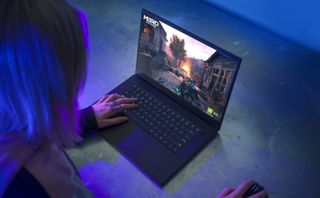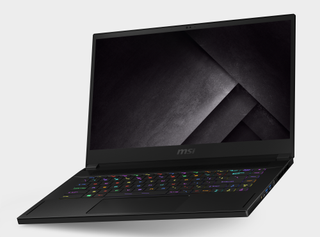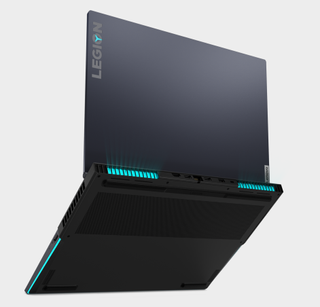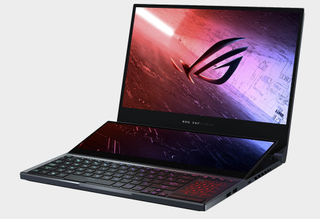All the next-gen Intel and Nvidia gaming laptops and when you can buy them
Everything we know about the super laptops coming our way.

Nvidia announced its laptop RTX 2070 Super and RTX 2080 Super GPUs at the start of the month, revealing higher specs and updated Max-Q technology. That means not only are these new, more-powerful GPUs making their way into traditional gaming laptops, but also into a slimline ultrabook-esque aesthetic too.
At the same time, Intel announced its new 10th Gen laptop processors. So there are plenty of new powerful gaming laptops on the way. Machines that pack Intel's latest Comet Lake H-Series CPUs alongside Nvidia 20-Series Super GPUs. But which laptop manufacturer is making what, how much will they cost, and when can we expect them to appear? That's exactly what I'm outlining here.
I've concentrated on gaming laptops that pack the double whammy of the latest hardware from Intel and Nvidia only. There are plenty of other machines on the way that have one and not the other, but we're gamers on the leading edge here, so we're only interested in powerful new laptops with graphical grunt. We're pretty hopeful you'll soon find some of the entrants below on our best gaming laptop guide.
It's worth pointing out that there are also new $999 RTX 2060 gaming laptops hitting the virtual shelves around now too. You can expect our first review from that group, the MSI GF65, any day now.
MSI

MSI GS66 Stealth
Price: From $1,599 (£1,699) Availability: Now
MSI is keen to point out that it's in a great position to get its next-gen gaming laptops onto shelves quicker than most. I've already taken a look at the engineering sample of the GS66 Stealth, and came away impressed by its sleek looks as well as how quiet it is. That was an preview build though, so I'm keen to see if MSI can keep the noise down when trying to cool an RTX 2080 Super.
As ever there are a wide range of GS66s on the way, with a price range to match—from an RTX 2060 Max-Q alongside an i7 10750H for $1,599, all the way up to the RTX 2080 SuperMax-Q operating alongside the Core i9 10980HK for $2,999. That top model comes with 32GB of DDR4-2666 RAM, a 1TB NVMe drive, and a 300Hz 3ms 1080p display. There are a few different spins in between, though you'll hit north of $2,400 very easily, so this may not be a machine for budget gamers.
PC Gamer Newsletter
Sign up to get the best content of the week, and great gaming deals, as picked by the editors.
The professional vibe of the machine may have you thinking that this is one for business types, especially given that it's a thin and light system. But the fact MSI has worked with Steelseries for the keyboard can give the game away a little, especially if you turn on the per-key RGB lighting. Killer makes an appearance on the networking side as well, with its Wi-Fi 6 supporting AX1650i. This machine is potentially a bit of a goer too, packing a 99.9Whr battery into it's slim form.

MSI GE66 Raider
Price: From $1,799 (£1,799) Availability: May 2020
The MSI GE66 Raider meanwhile draws more from the traditional gaming laptop school of design, with an RGB strip along the front to show off your gaming colors (whatever they may be) and a slightly bulkier look all round. It's not as thin or light as the GS66, but that does mean there's a bit more room for cooling, so it'll be interesting to see if that gives the Raider a slight edge when it comes to performance.
The GE66 Raider will still feature that 99.9Whr battery, so it should last just as long as the GS66 Stealth, and the pricing and core components aren't too different either—starting at $1,799 (£1,799) for a Core i7 10750H and RTX 2070, all the way up to a i9 10980HK in tandem with a RTX 2080 Super for $2,999 (£2,999). The GE66 Raider is expected to drop shortly after the GS66 in the May timeframe.
Gigabyte

Gigabyte Aorus 15G, 17G, and 17X
Price: From $1,699 (£1,699) Availability: Now
Gigabyte has been quick to jump onboard the new hardware bandwagon, and has two laptops lines on the way that employ Intel 10th Gen Comet Lake H-series processors and Nvidia GeForce RTX 20-series Super mobile graphics. The Aero line is aimed more at creative types, so we'll pass over them for now, and instead focus on the 'professional gaming' laptops that make up the Aorus line.
As the names suggest, there are two different sizes available here: the Aorus 15G is a 15.6-inch laptop (starting from $1,699), while the 17G (from $1,799) and 17X (from $2,399) are both 17.3-inch models. The styling of the 15G and 17G are identical, while the 17X has a more obvious gaming bent, with RGB light strips on the front edges. All three laptops use Omron mechanical keyboards and can house up to a 240Hz refresh rate displays.
As for what is going inside the machines, Gigabyte has announced that there are three Intel 10th Gen CPUs being used: the Core i9 10980HK, i7 10875H, and 10750H. We've seen plenty of mentions of the 10980HK and 10750H in other laptops, but the 10875H could be an interesting chip to watch. It's an 8-core, 16-thread chip that shouldn't command the same price as the top-end 10980HK. It doesn't quite hit the same turbo as that chip, but at 5.1GHz it should be able to hold its own as well. There are also options for 2070 Super and 2080 Super GPUs in these machines.
There are several variations of the Aorus laptops available, so this is probably the easiest way of getting your head around what's available (and these are just the latest edition to the Aorus family, there are plenty of other skus available):
| Price | Processor | Graphics Card |
|---|---|---|
| $1,699 | Intel Core i7 10750H | Nvidia GeForce GTX 1660Ti |
| $2,199 | Intel Core i7 10875H | Nvidia GeForce RTX 2070 Super |
| $2,899 | Intel Core i9 10980HK | Nvidia GeForce RTX 2080 Super |
| Price | Processor | Graphics Card |
|---|---|---|
| $1,799 | Intel Core i7 10750H | Nvidia GeForce GTX 1660Ti |
| $2,299 | Intel Core i7 10875H | Nvidia GeForce RTX 2070 Super |
| $2,799 | Intel Core i7 10875H | Nvidia GeForce RTX 2080 Super |
| Price | Processor | Graphics Card |
|---|---|---|
| $2,299 | Intel Core i7 10875H | Nvidia GeForce RTX 2070 |
| $2,499 | Intel Core i7 10875H | Nvidia GeForce RTX 2070 Super |
| $3,699 | Intel Core i9 10980HK | Nvidia GeForce RTX 2080 Super |
Each of these laptops has the webcam below the screen, which won't be to everyone's taste, unless you enjoy showing people the inside of your nose.
Razer

Razer Blade 15 (2020)
Price: From $1,599 (£1,599) Availability: May 2020
Razer has announced that Nvidia RTX Supers and Intel 10th Gen chips are coming to its Blade 15 laptop, along with a 300Hz display, and a slightly reworked keyboard. It's going to be home to the Core i7 10875H (8 core, 16 thread), which is potentially capable of hitting a turbo of 5.1GHz, although we'll have to wait and see how long this super thin laptop can maintain such speeds.
For the graphics subsystem you have the option of going with the Max-Q RTX 2070 Super or 2080 Super in the 'Advanced model', although they cost considerably more than the 'Base model' which comes with a 1660 Ti for $1,599. There are 2060 and 2070 Max-Q variants as well in the 'Base model' though, which gives you options. You'll also get access to 16GB of DDR4-2933 RAM as standard, and Razer has sided with Intel on the networking front, employing the Wi-Fi 6 AX201 for wireless connectivity.
You can configure your machine over at Razer's site, where it's easy to hit silly prices in just a few clicks. Selecting an RTX 2070 Super Max-Q, 10th Gen i7 10875, Full HD 300 Hz display, and 512GB SSD produces a price of $2,599. Selecting a 2080 Super Max-Q removes the price though, so we're not sure how much that'll end up costing.
Lenovo

Lenovo Legion 7i
Price: From $1,599 (£1,599) Availability: May 2020
Despite what you may assume from the name, the Legion 7i is actually a 15-inch laptop (not a 17-incher) that employs the latest tech from Nvidia and Intel. There's support for up to a 10th Gen Core i9, GeForce RTX 2080 Super Max-Q, along with 1TB of PCIe SSD storage and 32GB of DDR4 RAM. Lenovo has already stated that the Legion 7i will stick with a 1080p display, but that you'll get to choose between a 144Hz and 240Hz IPS panel.
Lenovo is using its TrueStrike keyboards on the Legion 7i, which feature 100% anti-ghosting, sub-millisecond response times, a 1.3mm travel, and soft landing switches. This keyboard will also light up like a christmas tree, thanks to support for Corsair iCue lighting. You get an 80WHr battery for your money as well, which may not be as impressive as some of the 99.9WHr systems around, but Lenovo does have a good reputation of squeezing great battery life out of its machines.
In other news, Lenovo will be producing two different versions of the Legion 5, one called the Legion 5i which uses an Intel 10th Gen CPU and the Legion 5 (without the i) that uses an AMD Ryzen 4000 H-series processor. These models top out with an RTX 2060 for the graphics side of things, but it'll still be interesting to see which one outperforms the other.
Acer

Acer Predator Triton 500
Price: From $2,199 (£1,999) Availability: June/July 2020
The Acer Predator Triton 500 is being updated to take onboard the new silicon from Intel and Nvidia, although we're not sure at this point if the older silicon is being retired, so it pays to look closely at the specifications to make sure you're getting the hardware you want. RTX 2070 Super and RTX 2080 Super Max-Q GPUs are being added to the family, along with 10th Gen Intel Core i7 processors (although the exact models still haven't been revealed).
One of the more interesting aspects of this machine is the 15.6-inch screen, which can be tooled out with a 300Hz, 3ms response time, IPS panel complete with supports for Nvidia's G-Sync. If you go for the more-expensive RTX 2080 Super version, then this makes for a potentially tasty gaming machine that actually has the horsepower to make that refresh rate useful. Such a system does come with a $2,599 (£2,499) price tag though, so start saving now.
This is a gaming laptop through and through, so that means that you get per-key RGB lighting, which can make for some lurid setups, as per the norm. It's good to get support for Wi-Fi 6 straight out of the box though, which comes courtesy of the Killer AX1650 chip, and Killer is also onboard for wired connections with its 2.5G E3100. You can configure the machine with up to 32GB of DDR4-2933 RAM and 2TB of NVMe storage as well.
Laptop cooling is one of the fundamental areas where manufacturers can differentiate themselves, and in the Triton 500 uses Acer's 4th gen Aeroblade 3D technology. There are some neat features here, including serrated edges to the three fans for improved performance (inspired by owls no less), winglets on the top and bottoms of the blades to reduce noise levels, and each fan has 59 blades that are a 0.1mm thick, so it's an impressive engineering feat as well.
We originally expected these machines to start shipping in May, but it now looks like this has been pushed back slightly due to the impact of the coronavirus on supply lines. Still this looks like a powerful yet compact machine that may be worth holding out for.
Asus

Asus Zephyrus Duo 15
Price: From $2,999 (£2,999) Availability: July 2020
Asus has a number of refreshed laptops on the way, with the new silicon making its way into several existing lines, but the stand out model right now is the ROG Zephyrus Duo 15, which boasts two screens—one above the keyboard to complement the traditional screen. The Duo 15 will be available in a couple of guises, with either an Intel Core i9 10980HK or an i7 10870H alongside an RTX 2080 Super or a 2070 Super. You can read up on Jacob's thoughts after having some Zephyrus Duo 15 hands-on time with it.
That's not the only new machine coming from Asus, or even from the other laptop manufacturers, such as HP Omen, and we'll be updating this list as and when more details appear.
Alan has been writing about PC tech since before 3D graphics cards existed, and still vividly recalls having to fight with MS-DOS just to get games to load. He fondly remembers the killer combo of a Matrox Millenium and 3dfx Voodoo, and seeing Lara Croft in 3D for the first time. He's very glad hardware has advanced as much as it has though, and is particularly happy when putting the latest M.2 NVMe SSDs, AMD processors, and laptops through their paces. He has a long-lasting Magic: The Gathering obsession but limits this to MTG Arena these days.
Most Popular


